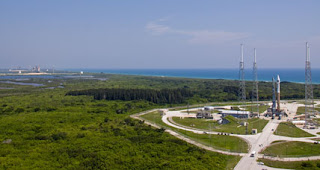 NASA's Lunar Reconnaissance Orbiter, or LRO, and the Lunar Crater Observation and Sensing Satellite, or LCROSS, rolled aboard their Atlas V rocket to the launch pad at Cape Canaveral Air Force Station in Florida Wednesday morning in preparation for launch on Thursday. The spacecraft left its processing facility at 10:02 EDT and arrived at the pad about 35 minutes later.
NASA's Lunar Reconnaissance Orbiter, or LRO, and the Lunar Crater Observation and Sensing Satellite, or LCROSS, rolled aboard their Atlas V rocket to the launch pad at Cape Canaveral Air Force Station in Florida Wednesday morning in preparation for launch on Thursday. The spacecraft left its processing facility at 10:02 EDT and arrived at the pad about 35 minutes later.
The spacecraft are scheduled to lift off together on Thursday, June 18, with three attempts possible at 5:12 p.m., 5:22 p.m. and 5:32 p.m. If launch slips to Friday, June 19, the launch opportunities would be 6:41 p.m., 6:51 p.m. and 7:01 p.m.
LRO is scheduled for a one-year exploration mission at a polar orbit of about 31 miles, or 50 kilometers, the closest any spacecraft has orbited the moon. Its primary objective is to conduct investigations to prepare for future explorations of the moon. LCROSS will search for water ice on the moon by sending the spent upper-stage Centaur rocket to impact part of a polar crater in permanent shadows. LCROSS will fly into the plume of dust left by the impact and measure the properties before also colliding with the lunar surface.
NASA TV coverage of the launch will begin at 2 p.m. June 18. For information about NASA TV streaming video, downlink and schedule information, visit:
For more information about the LRO and LCROSS missions, visit:















